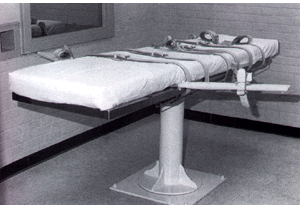The Executioner's Diary /
Methods / back /
next
 "He's made his bed, and now he's having to lie in it"
"He's made his bed, and now he's having to lie in it"
Ronald Clark O'Bryan's former wife on his execution in 1984
In the search for a humane and clean way of executing people, authorities in Texas decided that death by
lethal injection, using a combination of drugs, would be the cleanest and easiest way of putting a
person to death.
The drugs used in this method are as follows:
Sodium Thiopental: This is normally used to anethetize patients prior to an operation.
It is a barbiturate and is used to depress the central nervous system and caused cardiac arrest.
Pancuronium Bromide: More commonly known as Pavulon, this is a synthetic drug which compares
with Curare. This is to paralyse the cardiac muscles and thus cause death by suffocation due to lack of
oxygen to the blood.
Potassium Chloride: A natural electrolyte produced by the body, it regulates the action of the heart. By introducing an overdose of
this electrolyte it will cause cardiac failure.
The drugs are introduced into the body by an intravenous tube, primed with a saline solution.
The victim is placed on a gurney and strapped down. A medical technician then inserts the intravenous needle into
a suitable vein. This can cause problems if the victim has a previous history of hard drug abuse. On completion the saline
solution is started. At the sign from the warden, the three drugs are introduced through three plungers
activated by either electronic circuits or by hand. In some states there are three executioners, and one of the plungers is connected to
a dummy tube which drains into a container, thus none of the persons can claim to have injected the lethal doses of drugs.
As this method of execution became popular with other states, medical ethics were called into question. Many doctors refused
to have anything to do with the actual process, confining themselves to pronouncing death. As mentioned before, there may be problems
finding veins and officials might call on the doctor to open a vein to admit the needle. The American Medical Association, after a long debate,
ruled that doctors performing this service were not contravening medical ethics.
Despite claims that death would be instant, painless and clean, problems have occured, namely:
1. The Intravenous Catheter becomes blocked during administration of the drugs, leading to a slow introduction and,
consequently, a slow death.
2. The victim's veins may be so poor that they cannot cope with the pressure of the Intravenous Catheter and may collapse, or that the needle will
fall out of the arm during administration of the drugs.
3. In one case, it took 40 minutes to find a suitable vein for the needle.